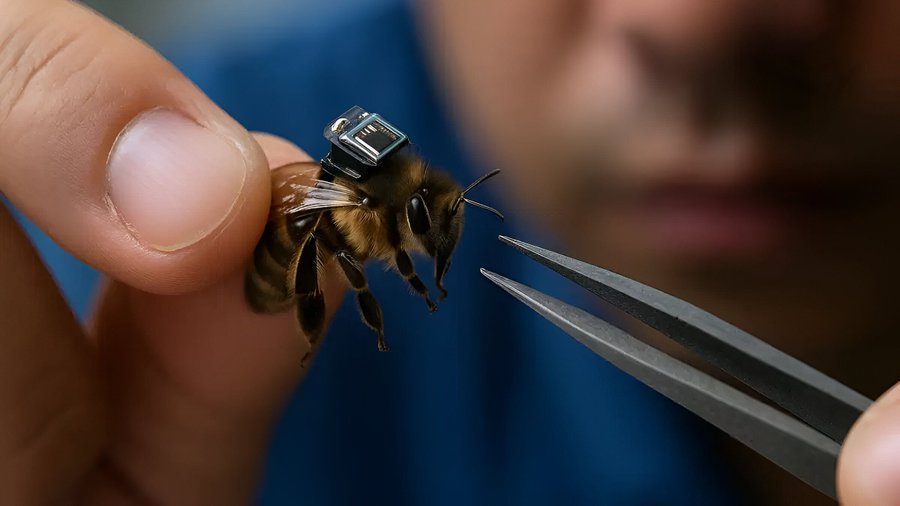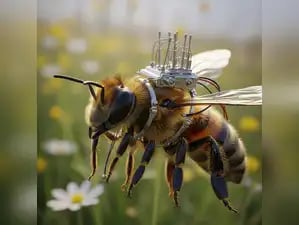Chinese Scientists Develop World’s Lightest Brain Chip to Steer Bees
Beijing, July 15, 2025 — In a breakthrough that sounds like something out of science fiction, scientists in China have developed the world’s lightest brain chip—weighing just 74 milligrams—that can control the movements of a live honeybee. This tiny device, lighter than a droplet of water, allows researchers to guide the insect’s flight remotely with surprising precision.
TECHNOLOGY
Thinkbrief
7/15/20253 min read


In a breakthrough that sounds like something out of science fiction, scientists in China have developed the world’s lightest brain chip weighing just 74 milligrams that can control the movements of a live honeybee. This tiny device, lighter than a droplet of water, allows researchers to guide the insect’s flight remotely with surprising precision.
The chip was created by a team at the Beijing Institute of Technology, led by Professor Zhao Jieliang, and was recently published in the Chinese Journal of Mechanical Engineering. With this innovation, researchers have taken a major step toward integrating biology and technology in real-world environments.
How Does It Work?
The chip is mounted directly on the back of a bee and connects to its nervous system through three micro-needles. These needles deliver small electrical signals to specific areas of the bee’s brain, allowing researchers to send simple directional commands go left, go right, move forward, or back. According to the team, bees responded accurately about 90 percent of the time.
What makes this technology especially impressive is its size and weight. At just 74 milligrams, the chip is light enough not to interfere with the bee’s natural flying ability. Bees regularly carry that much or more in nectar when foraging, so this added weight doesn’t slow them down.
The team designed the chip using ultra-thin flexible film and microscopic circuitry to keep it light and compact. It’s significantly smaller and more efficient than any similar system tested on insects like beetles or cockroaches.
Why Use Bees?
Bees are already some of the most impressive flyers in the natural world. They can hover, zip through tight spaces, and fly for extended periods all without needing batteries or GPS. By working with bees instead of building tiny flying robots from scratch, researchers can take advantage of millions of years of natural design.
And bees aren’t just great flyers they’re already familiar with the outdoors and complex environments, making them perfect candidates for missions in places drones can’t go.
What’s the Point?
So, why create “cyborg bees”? The technology opens the door to several exciting and some slightly unsettling possibilities:
Search and rescue: In disaster zones, tiny flying agents like these could search for survivors in places too dangerous or tight for people or drones.
Environmental monitoring: Bees fitted with sensors could collect data on air quality, temperature, or gas leaks in hard-to-reach areas.
Agriculture: These bees could assist with crop monitoring or even deliver targeted pollination.
Surveillance: A more controversial use might include covert operations, as bees can easily enter buildings without being noticed.
The idea isn’t entirely new. In the past, scientists have experimented with controlling beetles and cockroaches using heavier, less precise systems. But this new brain chip is smaller, smarter, and more suited to practical use in the field.
Still Some Hurdles to Clear
Right now, the bee-chip combo still has a few limitations. The system is wired and currently requires a power source connected through a tether. Adding a battery is tricky because any extra weight could keep the bee from flying properly.
Also, while the chip works well in lab conditions, not all bees respond exactly the same. Each insect may need slightly different calibration, so scaling up to large numbers of “cyborg bees” will take more research and refinement.
The team is now focused on making the chip fully wireless and possibly biodegradable important steps if it’s going to be used widely or outdoors.
What About Ethics?
Naturally, controlling a living creature’s brain raises ethical questions. Is it right to guide an animal’s behavior for human purposes, even if it’s for good causes like saving lives or protecting the environment?
There are also concerns about misuse. If this technology can be used to spy or intrude on privacy, who decides when and how it should be used?
The researchers say their goal is to use this discovery responsibly and for the benefit of society. They acknowledge that as this kind of technology advances, public discussion and strong ethical guidelines will be essential.
The Big Picture
The development of this 74 mg brain chip is a big leap in how we think about combining nature and machines. Rather than replacing insects with artificial drones, scientists are now enhancing what nature already does well. It’s a blend of biology and engineering that could reshape how we respond to emergencies, care for the planet, and even explore the unknown.
But like all great innovations, it comes with big questions ones we’ll need to answer together.

